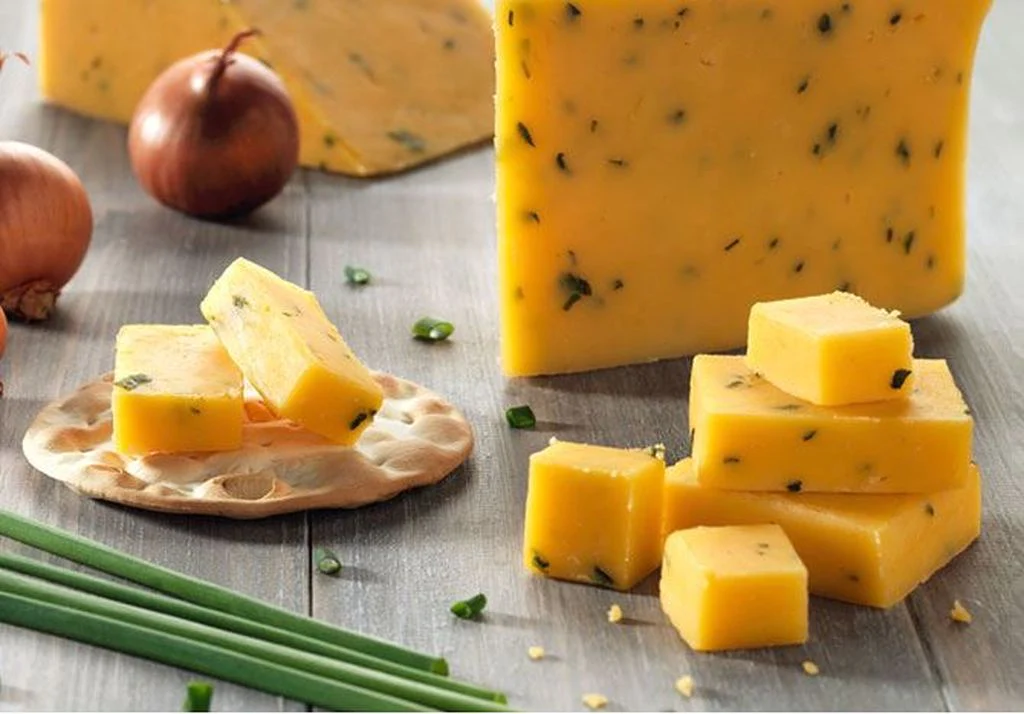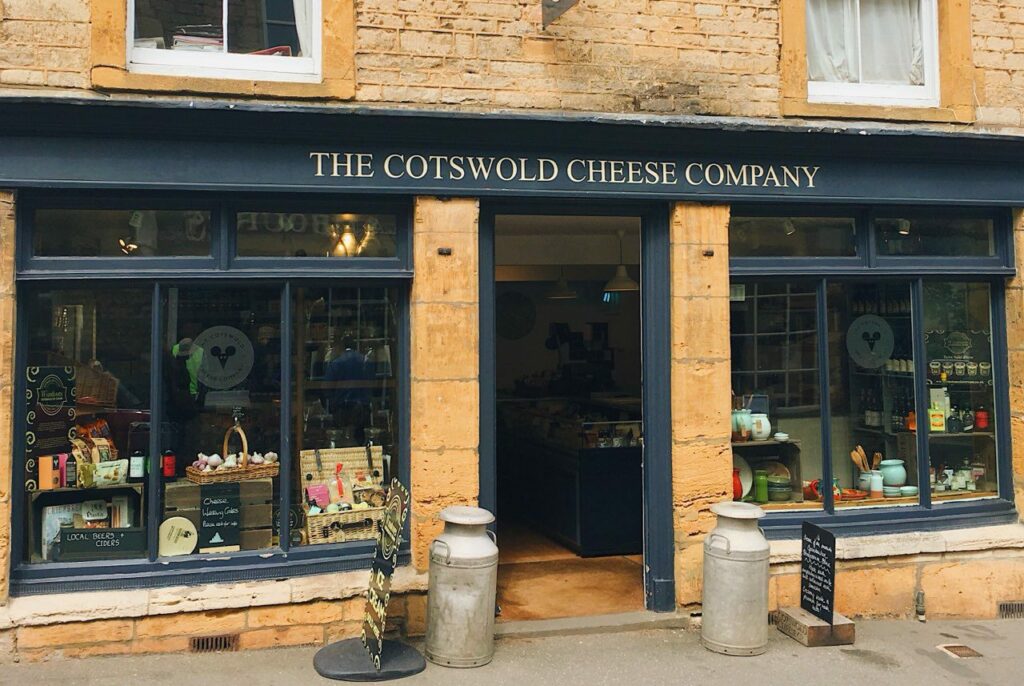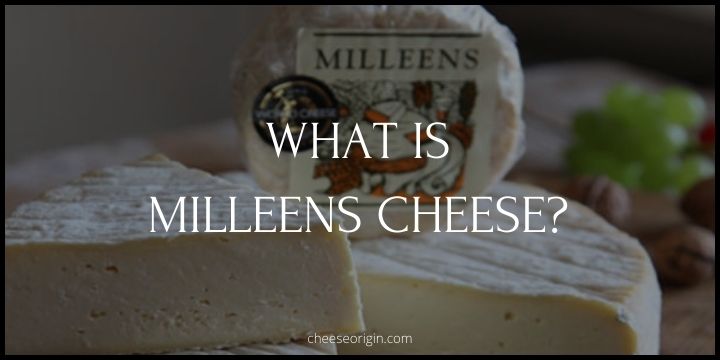What is Cotswold Cheese? A Taste of England’s Finest

This exquisite culinary delight, often known as ‘Pub Cheese,’ is a testament to the region’s rich dairy heritage and the mastery of its cheesemakers.
In our journey through England’s finest, we are going to delve into the creamy, full-bodied flavor of Cotswold Cheese, a delicacy that perfectly balances the robustness of Double Gloucester with the subtle tang of chives and onions.
With every bite, it’s like taking a gastronomic tour of the quintessential English countryside.
Also read: Top 10 Most Popular England Cheeses
Quick Facts About Cotswold
| Cotswold Cheese Quick Facts | Description |
|---|---|
| Origin | England |
| Milk Source | Cow’s milk |
| Texture | Semi-hard and open |
| Flavor | Creamy, buttery, with strong, chive and onion notes |
| Color | Orange or yellow |
| Aging Process | Typically aged for about 8 to 12 weeks |
| Uses | Ideal for sandwiches, melting in dishes, and pairing with beers and wines |
| Production Process | Double Gloucester cheese base infused with chopped onions and chives |
What kind of cheese is Cotswold?

Cotswold cheese is a full-flavored, creamy variety that originates from Gloucestershire County in England. It is made from whole cow’s milk, which can be either pasteurized or unpasteurized.
This hearty cheese is a type of Double Gloucester enriched with chives and onions, giving it a unique and robust flavor profile. It is often referred to as “Pub Cheese”. Despite its creamy texture, Cotswold is a higher-moisture cheese that ripens earlier than most cheddars.
This cheese is quite popular and versatile, enjoyed by both children and adults alike. Its rich, tangy taste makes it a favorite in many households and a staple in English pubs.
In addition, Cotswold cheese is part of a broader collection of hard, soft, blue, and goat’s cheese from around the Cotswolds, showcasing the region’s rich dairy heritage.
What does Cotswold cheese taste like?
Cotswold cheese has a distinct, robust flavor that’s well-loved by many. It’s a full-flavored cheese with a creamy, smooth texture that’s both rich and buttery.
The addition of chives and onions gives Cotswold cheese an extra layer of savoriness, adding a tangy, oniony note to its overall taste profile. This makes it quite unique compared to other types of cheese.
Its flavor is often described as bold and hearty, which makes it a popular choice for sandwiches, particularly in English pubs. Despite its strong flavor, Cotswold cheese is also known for its approachability, making it a hit with both children and adults alike.
Cotswold cheese tasting notes
- Texture: Creamy and smooth, with a firm consistency that’s easy to slice.
- Flavor: Full-bodied and robust, with a rich, buttery taste.
- Additional Notes: The inclusion of chives and onions provides a tangy, savory undertone.
- Aftertaste: Lingering richness with a pleasant oniony finish.
- Pairings: Pairs well with hearty breads, cold meats, and traditional English ales.
- Overall: A bold yet approachable cheese that’s loved for its unique flavor profile.
What do you do with Cotswold cheese?
Cotswold cheese is versatile and can be used in a variety of dishes or enjoyed on its own. Here are some suggestions:
- Cheese Board: Cotswold cheese makes a great addition to any cheese board, paired with fruits like apples and grapes, and complemented by various crackers or artisan breads.
- Sandwiches: The robust flavor of Cotswold cheese goes well in sandwiches, especially when paired with cold meats or simply melted between slices of bread.
- Cooking: Cotswold cheese can be used in cooking, adding depth to dishes like quiches, omelettes, or casseroles.
- Grating: It can be grated over salads or pasta dishes for an added punch of flavor.
- Pairing: Cotswold pairs well with a good English ale or a robust red wine.
- Snacking: It’s also delicious simply sliced and eaten as a snack.
Like many cheeses, Cotswold is best served at room temperature to fully appreciate its flavor.
Is Cotswold cheese similar to cheddar?
Cotswold cheese has been compared to Cheddar due to its creamy, buttery, and full-flavored taste. However, they are not the same.
| Cotswold | Cheddar | |
|---|---|---|
| Origin | England | England |
| Texture | Creamy, firm, and smooth | Firm to hard, depending on age |
| Flavor | Rich, buttery, tangy due to the addition of chives and onions | Nutty, sharp to extra sharp depending on aging |
| Color | Natural, pale yellow | From white to pale yellow, orange if colorings are added |
| Aging | Typically 1-3 months | Varies widely, from a few months to over 2 years for aged varieties |
| Uses | Cheese boards, sandwiches, cooking, grating, snacking | Cheese boards, sandwiches, cooking, grating, sauces |
| Pairings | English ales, robust red wines | Ales, stout, robust red wines, cider |
Cotswold is a variant of Double Gloucester cheese, which is another traditional English cheese. It’s peppered with chives and onions, giving it a unique flavor profile that Cheddar does not have.
While both cheeses share a similar creamy texture, Cotswold tends to have higher moisture content and ripens earlier than most Cheddars. This results in a distinct difference in the taste and texture between the two.
Moreover, the addition of chives and onions to Cotswold gives it a savory dimension that Cheddar lacks. This combination of flavors gives Cotswold an “added zing” that sets it apart from Cheddar.
While Cotswold and Cheddar may have some similarities, they are distinct in their own ways, each offering a unique flavor experience for cheese lovers.
>> Click here to read our in-depth guide on Cheddar
7 of the Best Cotswold Cheese substitutes
Here are 7 of the best substitutes for Cotswold Cheese:
- Meyer Vintage Gouda: This is a hard cheese from New Zealand that is highly regarded and could substitute the firm texture and rich flavor of Cotswold.
- Manchego: This Spanish cheese has a sweet and nutty flavor that can provide a different but equally satisfying taste profile.
- Cheddar: A classic English cheese, Cheddar can be a good substitute, especially if you’re looking for a cheese with a bit more sharpness.
- Caerphilly: This Welsh cheese is light and slightly tangy, offering a less intense flavor compared to Cotswold.
- Red Leicester: An English cheese known for its mild flavor and orange color, it could serve as a substitute in dishes where the bold flavor of Cotswold might be overpowering.
- Stinking Bishop: Another English cheese, this one has a strong smell but a relatively mild flavor, making it an interesting alternative to Cotswold.
- Cornish Brie: This soft and creamy cheese offers a different texture but can be a good substitute if you’re looking for something less firm than Cotswold.
Note that the flavor and texture of these substitutes may not perfectly match Cotswold, but they each offer unique characteristics that can make them interesting alternatives.
How expensive is Cotswold cheese?
The price of Cotswold cheese can vary depending on the retailer and the size of the product:
- A 16oz package of Cotswold Cheese is listed at $32.96 on Amazon.
- Ideal Cheese lists the price of Cotswold as $14.98 per pound, with a wheel size of 5lb.
- Lee’s Gourmet Direct offers Cotswold Cheese for $9.99. However, the website does not specify the weight of the product.
- Well Get The Food lists the price of Cotswold Cheddar as $3.79 per 8 oz.
Note that these prices might not include shipping costs and could vary based on location or other factors.
Is Cotswold cheese healthy?
Health benefits:
- Protein: Cotswold cheese is a good source of protein, which is essential for building and repairing body tissues among other functions.
- Calcium: Being a dairy product, it also provides a considerable amount of calcium which is necessary for healthy bones and teeth.
Considerations:
- Calories: Cotswold cheese is relatively high in calories compared to other cheeses, with around 110 calories per ounce.
- Fat: It is also high in fat, with around 71.7% of its calories coming from fat.
Cotswold cheese can be part of a healthy diet when eaten in moderation. However, due to its high calorie, fat, and sodium content, it should be consumed responsibly.
Cotswold nutrition facts
| Nutrition Facts | Amount (per 1 oz serving) |
|---|---|
| Calories | 110 cal |
| Total Fat | 9.1g |
| Protein | 6g |
| Sodium | 2300mg |
| Cholesterol | 300mg |
| Calcium | Good Source |
| Zinc | Good Source |
| Vitamin B12 | Good Source |
What is the history of Cotswold cheese?

Cotswold cheese, also known as “Pub Cheese,” is a rich, creamy cheese that hails from England. It’s named after the Cotswold region in the Southwestern part of the country, a place known for its gentle hills (‘wolds’) and sleepy villages.
The cheese itself is a variation of Double Gloucester, a traditional British cheese made from the milk of Gloucester cows. Double Gloucester is known for its smooth, buttery texture and slightly nutty flavor. Its history dates back to the 16th century, making it one of the oldest recognized types of British cheese.
Cotswold is essentially Double Gloucester that has been supplemented with chopped onions and chives for an extra savory kick. This variant became popular in the 1970s as a pub cheese, perfect for pairing with a pint of traditional British ale.
Despite its relative youth compared to some ancient cheeses, Cotswold has become quite popular and is now enjoyed all over the world, not just in British pubs. Whether served on a cheeseboard, melted into dishes, or enjoyed with crackers and a good beer, Cotswold cheese carries with it a little taste of English tradition and history.
What goes well with Cotswold cheese?
Food that goes well with Cotswold cheese
| Category | Foods |
|---|---|
| Cheese Pairings | Asiago, Blue, Brie, Brillat Savarin, Cambozola, Cheddar, Colby |
| Dishes | Cotswold Quiche, Ravioli with Apples and Walnuts, Pepperoni Pizza |
| Cooking Uses | Melted on a Potato Pierogi, Added to Scones, Melted over Potatoes |
| Accompaniments | Crackers, Applewood Smoked Bacon |
Also read: 11 Best Crackers that Pair Well with Cheese
Beverage that goes well with Cotswold cheese
| Category | Beverages |
|---|---|
| Beer Pairings | English Bitters, Brown Ale, IPA |
| Wine Pairings | Chardonnay, Cabernet Sauvignon, Chianti, Chateauneuf-du-Pape |
| Non-Alcoholic Pairings | Lemonade |
Also read: Best Wine and Cheese Pairings: The Ultimate Guide
Frequently Asked Questions:
1. Is Cotswold a soft cheese?
Cotswold cheese is not typically classified as a soft cheese. It’s a variation of Double Gloucester, which is a semi-hard to hard cheese.
Cotswold itself has a creamy and buttery texture similar to cheddar, and it can become semi-soft at room temperature. However, it’s important to note that the cheese retains a certain firmness even when it’s at its softest.
Despite its creamy consistency, it’s not a high-moisture cheese like many soft cheeses, and it ripens earlier than most cheddar varieties. So, while Cotswold might be creamier than some hard cheeses, it doesn’t quite fall into the soft cheese category.
2. Is Cotswold pasteurized?
Yes, Cotswold cheese is typically pasteurized. This delicious variety of Double Gloucester cheese hails from the United Kingdom and is often made using pasteurized cow’s milk.
It undergoes a pasteurization process to ensure its safety and extend its shelf life. Some manufacturers of Cotswold cheese use Grade A full-fat milk from their Holstein herd and then pasteurize it for their version of this cheese.
In addition, Cotswold cheese can be found in both processed and “natural” versions, but regardless of the variant, it tends to be a pasteurized, crumbly, yellow-orange color cheese.
3. Where is Cotswold cheese from?
Cotswold cheese originates from the picturesque Gloucestershire County in England, a region renowned for its rolling hills and lush landscapes.
The cheese is named after this area, known for its scenic beauty and pastoral charm.
The production of Cotswold cheese, a variant of Double Gloucester cheese, has been a tradition in this region since the 16th century. Today, it continues to be produced in this area, with some dairies even offering their own unique spins on the original recipe.
4. Is Double Gloucester a Cotswold cheese?
Double Gloucester is a traditional, semi-hard cheese from England that shares a close connection with Cotswold cheese, but they are not the same. Double Gloucester is made from the milk of Gloucester cows, and it’s known for its firm texture and mild, creamy flavor.
Cotswold cheese, on the other hand, is a variation of Double Gloucester. It’s essentially Double Gloucester cheese that has been flavored with chopped onions and chives. This gives Cotswold cheese its unique, robust flavor that sets it apart from the more subdued Double Gloucester. So, while all Cotswold cheese is Double Gloucester, not all Double Gloucester is Cotswold.
5. How to properly store Cotswold cheese?
- Wrap it correctly: Never use plastic wrap. Instead, opt for cheese paper, wax paper, or parchment paper. These materials allow the cheese to breathe while retaining necessary moisture.
- Refrigerate it: Store your wrapped Cotswold cheese in the refrigerator’s vegetable drawer or a dedicated cheese drawer if you have one. These areas provide the right amount of humidity needed by the cheese.
- Avoid strong odors: Cheese can easily absorb other flavors, so avoid storing it next to foods with strong odors.
- Check regularly: Check on your cheese every few days to make sure it’s not drying out or developing mold. If it is, remove the affected area immediately.
- Bring to room temperature before serving: While refrigeration is necessary for storage, Cotswold cheese is best enjoyed at room temperature. So, take it out of the fridge about an hour before you plan to serve it.
Note: Fresh cheeses like Cotswold are best consumed within two to three weeks of purchase.
Also read:
- Discovering Panela: A Guide to Mexico’s Versatile Cheese
- All About Swiss Cheese: A Comprehensive Guide
- Utz Cheese Balls: The Ultimate Guide (Taste the Tradition)
- A Guide to Havarti: The Star Cheese of the Culinary World
- The Ultimate Guide to Hoop Cheese: A Southern Delight
- Cheese Curds: The Unsung Heroes of the Dairy World
- Fior di Latte: A Comprehensive Guide to Italy’s Creamy Delight





